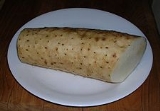
Dioscorea opposita
Overview
Dioscorea opposita (nagaimo, yamaimo, Chinese yam, Japanese mountain yam, Korean yam; syn. D. batatas, D. oppositifolia) is a type of yam
(Dioscorea
) that may be eaten raw.
Dioscorea opposita is an exception to the rule that yams must be cooked before consumption (due to harmful substances in the raw state). In Japanese cuisine
, it is eaten raw and grated, after only a relatively minimal preparation: the whole tuber
s are briefly soaked in a vinegar-water solution, to neutralize irritant oxalate
crystals found in their skin.
Yam (vegetable)
Yam is the common name for some species in the genus Dioscorea . These are perennial herbaceous vines cultivated for the consumption of their starchy tubers in Africa, Asia, Latin America and Oceania...
(Dioscorea
Dioscorea
Dioscorea is a genus of over 600 species of flowering plants in the family Dioscoreaceae, native throughout the tropical and warm temperate regions of the world. The vast majority of the species are tropical, with only a few species extending into temperate climates...
) that may be eaten raw.
Dioscorea opposita is an exception to the rule that yams must be cooked before consumption (due to harmful substances in the raw state). In Japanese cuisine
Japanese cuisine
Japanese cuisine has developed over the centuries as a result of many political and social changes throughout Japan. The cuisine eventually changed with the advent of the Medieval age which ushered in a shedding of elitism with the age of shogun rule...
, it is eaten raw and grated, after only a relatively minimal preparation: the whole tuber
Tuber
Tubers are various types of modified plant structures that are enlarged to store nutrients. They are used by plants to survive the winter or dry months and provide energy and nutrients for regrowth during the next growing season and they are a means of asexual reproduction...
s are briefly soaked in a vinegar-water solution, to neutralize irritant oxalate
Oxalate
Oxalate , is the dianion with formula C2O42− also written 22−. Either name is often used for derivatives, such as disodium oxalate, 2C2O42−, or an ester of oxalic acid Oxalate (IUPAC: ethanedioate), is the dianion with formula C2O42− also written (COO)22−. Either...
crystals found in their skin.
Unanswered Questions

